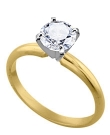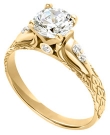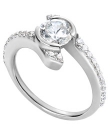Top Sellers
14K Yellow Gold 2.8 mm Medium Weight Solitaire Engagement Ring

https://www.danforthdiamond.com/
14K Yellow Gold Engraved Engagement Ring with Round Diamonds (.09 ct. tw.)

14K White Gold Bypass Ring with Bezel Setting and Diamond Sidestones (.34 ct. tw.)

Testimonials
Just wanted to say thank you for such a good job with the engagement ring by ordering something else.
You guys are awesome. My fiancé has had so many compliments on her ring. Thanks again.
James Corey II
Colored Diamonds
What is a colored diamond?
When Ben Affleck proposed to Jennifer Lopez, the act generated the expected amount of media attention. However the majority of that coverage wasn't focused on the total number of the couple's prior marriages, or that "Bennifer" name smashup the couple had been adorned with. No, the focus of the majority of mass speculation was the color of Jennifer's diamond.
They Come In Pink?
Ms Lopez's engagement ring was topped with a tremendously large 6-carat pink diamond. The word that people seemed to cling to was pink. The realization that diamonds come in colors started to spread, contradicting everything taught about diamond color: the closer to clear, the more valuable the diamond. Was Jennifer's "pink diamond" actually a diamond?
Are They Still Diamonds?
In a word, yes. While the common color grading scale used for diamonds runs from D (completely clear) to Z (obviously yellow) there is an entire subset of diamonds which fall beyond the Z rating into the umbrella grade of "Fancy." Fancy diamonds still hold all of the other characteristics of a traditional white diamonds – the hardness, the technical measure of clarity, the cut, and carat are all the same.
A Scale All Their Own
Colored diamonds that fall outside of the white grading scale, still have to have a subjective color grade assigned to them. However, the grading scale for colored diamonds is considerably easier for the layman to understand. Colored diamonds with the faintest hints of color are given a grade of Faint. Lightly colored diamonds are either Very Light, or Light. The bolder colored diamonds, your truly fancy gems, are graded along a scale ranging from Fancy Light to Fancy Dark, with Intense, Vivid, and Deep breaking up the middle.
A Stone of Many Colors
As you might have guessed, pink isn't the only color for diamonds. The infamous, and rumored to be cursed, Hope Diamond is a 45.52 carat dark grayish blue diamond. Canary diamonds are a brilliant yellow. Both brown and black diamonds are both real and growing in popularity lately. Other colors include orange, red, green, and purple. According to the Gemological Institute of America and the International Gemological Institute, there are 27 official hues which span the color spectrum, and there are diamonds to fill each of those hues.
Not to Get Too Technical
How those diamonds gain those hues is a bit of a technical process. Essentially, when the diamonds are forming from pure carbon, the molecules arrange themselves into a cage called a crystal matrix. As the diamonds are crushed under the earth's pressure, that matrix closes in on itself. Occasionally, during that process, atoms from other elements such as boron, nitrogen, or hydrogen, will be trapped inside of those diamonds as their respective matrices close. The end result is the colored diamond. As one would rightly assume, when multiple gases are trapped in the diamond, you get diamonds of blended colors, like pink champagne diamonds.
Still Really Rare
While color is certainly one reason why people prize fancy diamonds, it's certainly not the only one. Fancy diamonds are exceptionally rare. Colored diamonds, with a Fancy or deeper color grade, account for a mere 1.8% of the entire world's diamonds. When that percentage is broken down by color, those percentages get even smaller. Canary diamonds, diamonds which are known for their brilliantly yellow hue, account for less than 0.1% of the world's diamonds. Factor in the other common diamond factors – the size of the stone, the inherent shape, and the sense of clarity, and colored diamonds of significant size and quality get even rarer still.
Why Choose a Colored Diamond?
Colored diamonds aren't for everyone or even for every type of jewelry. However, they do have some very strong selling points. The rarity of colored diamonds makes them special. The variety of colors means that colored diamonds can be used to convey not only the emotions associated with a traditional diamond, but also to cater to the specific tastes of the recipient. It's those strengths that allow colored diamonds to fill jewelry niches that traditional white diamonds could not. In the end, a colored diamond provides a new and unique spin on a familiar and classic idea.
